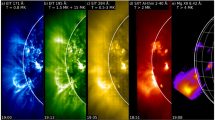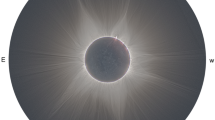Abstract
Using the observational data of the solar radio spectrometer with a broad bandwidth of the Chinese National Astronomical Observatories (CNAO), the Nobeyama Radio Heliograph (NoRH) and Polarimeters (NoRP), YOHKOH and SOHO satellites, it is found that there are two characteristics in an X3.3 flare event associated with coronal mass ejection (CME). (i) X-ray and EUV loop interaction and evolution appeared evidently in corona, followed by the formation of a twisted loop structure, which is consistent with the theoretical calculations of Amari et al. (1999a,b) for the origin of flare-CME events. (ii) The slow frequency drift was shown in the radio observations, corresponding to the relevant movement of the radio source observed by NoRH, at a speed of several tens kilometers per second, which may be associated with the speed of the shock waves resulting from the CME.
Similar content being viewed by others
References
Low, B.C., Coronal mass ejection, Solar Phys., 1999, 186: 337–343.
Pick, M., Demoulin, P., Maia, D. et al., Radio signature of coronal mass ejection, 9th European Meeting on Solar Physics, Italy, Sep., 1999, Heidelburg: Springer, 1999, 187–195.
Gopalswamy, N., Kundu, M. R., Thermal and nonthermal emissions during a coronal mass ejection, Solar Phys., 1993, 143: 327–343.
Aurass, H., Cerenal Physics Proceedings, Nouan Le Fuzelier, France, Tune 3–7, 1996 (ed. Torret, G.), Heidelburg: Springer, 1996, 135–158.
Fu, Q. J., Qin, Z. H., Ji, H. R. et al., Solar radio broadband spectrometer, Solar Phys., 1995, 160: 97–105.
Wood, B. E., Karovska, M., Chen, J. et al., Comparison of two coronal mass ejections observed by EIT and LASCO with a model of an erupting magnetic flux rope, Astrophys. J., 1999, 512: 484–490.
Dere, K. P., Brueckner, G. H., Howard, R. A. et al., LASCO and EIT observations of helical structure in coronal mass ejections, Astrophysics Journal, 1999, 516: 465–474.
Amari, T., Luciani, J. F., Confined disruption of a three-dimensional twisted magnetic flux tube, Astrophysics Journal, 1999a, 515: L81–84.
Amari, T., Luciani, J. F., Mikic, E. et al., Three-dimensional solutions of magnetohydrodynamic equations for prominence magnetic support: Twisted magnetic flux rope, Astrophysics Journal, 1999b, 518: L57–60.
Huang, G. L., Qin, Z. H., Yang, G. et al., Solar radio burst with positive and negative frequency drift, Astrophysics and Space Science, 1998, 259: 317–325.
Huang, G. L., Particle acceleration by periodic tearing mode instability, Adv. Space Res., 1990, 10(9): 173–176.




